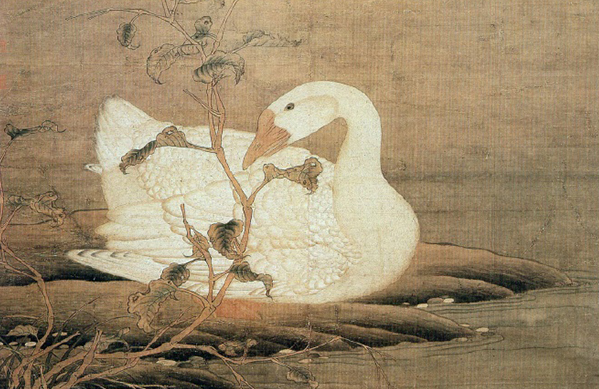
"The White Goose with Red Polygonum" by Emperor Huizong of Song Photo: FILE
The existent paintings attributed to the Northern Song emperor Zhao Ji (1082–1135), or Emperor Huizong of Song, vary in style. The renowned Chinese art connoisseur Xu Bangda (1911–2012) roughly classified these paintings into two types. One type is defined by a simple and unadorned style. Most paintings of this type are ink wash paintings (monochrome paintings using only shades of black) and lightly colored paintings of birds and flowers. The other type features detailed, accurately colored paintings of birds and flowers, figures, and landscapes. Not only are the simple and detailed paintings sharply different from each other, the techniques and tones applied on the detailed paintings vary considerably. Obviously, these paintings of mixed techniques and styles were not painted by one person. Studies reveal that most of these paintings were painted by someone else in the Emperor’s name.
The paintings created by artists from the imperial painting academy are mainly of meticulous, highly colored brush work, and usually depict items that represent wealth, prosperity, or good fortune, which were favored by imperial families. Emperor Huizong certainly liked these refined paintings. He probably signed and inscribed the paintings that charmed him. However, most of Huizong’s paintings were of the simple style, which better expressed his inner world.
Emperor Huizong's paintings of birds and flowers chase the most clear or essential spiritual characteristics through freehand brush work. He emphasized the charm of ink-washed art and poetic romance. Different from paintings by Su Shi (1037–1101) and Mi Fu (1051–1107), two dominant figures in Chinese art who focused on conveying their inner ideas and pursuits through rougher brush work with heavy line-weight and highly abstract images, Emperor Huizong's paintings are more technique-oriented and delicate. The birds and flowers in his paintings form an aesthetic kingdom where Huizong is the king. This may explain why Huizong's personal signature is "Tianxia Yiren," or "The Lone Man Under Heaven." Behind this signature probably lies the lonely heart of the emperor.
Three representative paintings are believed to be created by Emperor Huizong. The first one is "Crows in Willows & Wild Geese in Reeds." This painting is a handscroll, painted in ink and light colors on paper, and is in the Shanghai Museum’s permanent collection. This painting is made up of two separate images: "Crows in Willows" and "Wild Geese in Reeds." It represents a new way of painting that absorbs the essences of freehand brush work and gongbi (meticulous brush work). With the prominent use of black ink and subtle use of colors, the painting "Crows in Willows" depicts an old willow tree standing gracefully on a slope, which evokes the literary grace of the painting academy's artwork. Among the sparse weeds rests the most notable presence in the painting, the white-headed birds. The painting reveals an elegant simplicity. Behind the artistic achievements represented by the painting, is Huizong's strong vision developed from countless practices of painting directly from nature, and the ability to combine the meticulous brush technique of the academy of art with the spontaneity of literati. Viewers can feel Huizong's efforts in the precise, realistic depiction of the texture of the birds. The birds' feathers are portrayed as silky and delicate as though they are gifts from heaven.
The second painting is named "Autumn Evening in the Pond." It is an ink wash painting on paper, preserved in the Taipei Palace Museum. It is said that Emperor Huizong created this impromptu painting at a banquet in the Zichen Hall of the imperial palace. He drew the painting on a piece of fenjian paper, a type of paper with white mineral powder coating. A piece of newly produced fenjian paper has a reduced ability to absorb water, making the ink harder to blur. The texture of such paper enhances the vivid depiction of withered lotus in late autumn.
In the painting, Huizong portrayed a lotus plant taking its last breath. Its vines are bulging, laboriously supporting the wilting leaves. A lotus seed pod stands alone above the water. A little egret leans on a wilting lotus leaf, standing on one leg in a pond. It seems slim and fragile, but conveys a concentrated firmness. Through the brush technique of baimiao (literally "plain drawing"), Huizong produced a finely controlled, supple ink outline drawing, slowly and gently unveiling his understanding of ink wash painting.
The painting "The White Goose with Red Polygonum," painted on silk, is currently in the Taipei Palace Museum's collection. There is no signature of the artist on this painting. Therefore, whether or not it was painted by Emperor Huizong has been a contentious issue. The style of this painting leads one to believe that its painter is Emperor Huizong. Moreover, the paintings inscribed with Emperor Huizong's signature were often copied or painted by someone else, while paintings in Huizong's style but without the name of the painter might be Huizong's own paintings, because it ruled out the possibility of copy or being painted by someone else in the Emperor’s name.
The painting expresses an appreciation of tranquility. In the painting is a white goose, a red polygonum, and the gnarled roots of an old tree that reach out from soil. These elements constitute an image immersed in a subconscious feeling of loneliness. The white goose elegantly perches on the tree roots. The wilting leaves of the red polygonum suggest that the season depicted in the painting is a cold autumn, when the roots of the old tree are reaching for the future. Winter is coming. A pure, white creature is waiting for its destiny.
Li Dongjun is a professor from the Faculty of History at Nankai University.
Edited by REN GUANHONG

